If you haven’t heard of Solana yet, they’re a blockchain platform looking to take on Ethereum and similar smart contract platforms by offering faster transaction times and lower costs to their users.
But how can Solana make these claims? What sets them apart from the competition? How to buy solana? And should you be investing in them? Here’s everything you need to know about this new blockchain project.
What Is Solana?
Solana is a blockchain platform with smart contract functionality. Its native cryptocurrency is SOL, which has already been distributed in its ICO (Initial Coin Offering).
Unlike other crypto projects that offer faster transaction times and lower costs than their competitors, Solana claims to deliver on these promises.
But how exactly does it plan to do so? And what are its long-term plans for development?
Let’s take a closer look at how Solana works and whether or not it’s worth your investment.
How Does It Work?
The idea behind Solana is to use a special type of blockchain called DAG instead of more conventional blockchains like Ethereum or Bitcoin.
DAG stands for Directed Acyclic Graph, and it’s pretty different from blockchains that most people are familiar with.
A traditional blockchain store blocks linearly, which essentially means that there’s always a set order to how they’re organized on a chain.
In contrast, DAG-based systems don’t work in such a way; each node connects directly to other nodes rather than storing data sequentially.
This means that when new transactions come into play, they can be placed into an open spot on a chain without disrupting older data sets.
This makes Solana much faster than some other blockchain platforms. So fast, in fact, that it could potentially process tens of thousands of transactions per second (as opposed to just seven per second for Ethereum).
How to invest in Solana?
Like most other cryptocurrencies, there are many ways to get your hands on some Sol.
Each has its advantages and disadvantages, so let’s go over them here. If you have your methods of acquiring Sol, let us know.
We can add that to our list as well. Here’s how to invest in-
You can do so on Binance, KuCoin, or another exchange. The benefit of buying on an exchange is that it’s easy and convenient.
However, there are fees associated with buying on exchanges (which we won’t get into here). If you have your own methods of acquiring Sol, you can go with that.
What About Their Performance?
While Solana claims to offer lower transaction costs than other cryptocurrencies, it’s not clear how they’ll maintain those costs.
For instance, on-chain transactions can only be conducted at a certain rate; if more people use their platform, they’ll need to raise fees or add more servers to keep up with demand.
Solana may be using off-chain technology like Lightning Network, but that would mean slower confirmation times and higher volatility (as there are fewer network participants).
Will This Be A Profitable Investment?
The cryptocurrency market is volatile and risky for some investors.
But if your investment strategy is long-term, then it could be a very profitable investment if you see any of these cryptocurrencies becoming widely adopted: Bitcoin (BTC), Ethereum (ETH), Litecoin (LTC), and Ripple (XRP).
Even though I think Solana will get near those levels. However, there’s still plenty of room for growth and massive gains.
If you don’t have much money to invest in cryptocurrency or aren’t comfortable with that level of risk, then stay away from cryptocurrencies altogether.
You can also try dollar-cost averaging into cryptocurrencies over time by purchasing small amounts regularly to reduce your risk exposure.
